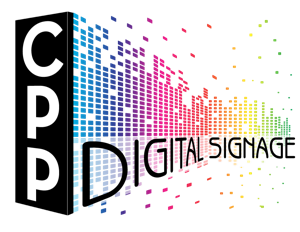A Quick Definition of Digital Signage
Digital Signage is a specialized form of video broadcast in which video or multimedia content is displayed for informational or advertising purposes. A digital sign usually consists of a computer or playback device connected to a large, bright digital screen such as a commercial-grade display. If the screen is attached to a computer or networked media player, the data on the display can be updated in real time using the Internet or proprietary network connection.
Dynamic digital signage is used in department stores, schools, libraries, office buildings, medical facilities, airports, train and bus stations, banks, auto dealerships and other public venues. It is also commonly used in corporate, employee-facing environments.
There are advantages that dynamic digital signs offer over printed or other types of static signs. The biggest advantage is that digital signs can be updated remotely when content needs to be changed (which makes them “dynamic”), while static signs require individual replacement and physical travel to sign sites by personnel. Digital signs can also be enhanced with visuals, video, and multimedia for more compelling presentations.
More engaging
Dynamic digital signage tends to be more engaging than static signage. This is true due to its ability to rotate the images, video and other content that is displayed on the screen frequently. The dynamic mode of presenting content enables it to give more information to targeted clients. On the other hand, static signage is very limited in providing enough information to the audience, as any change would require replacing the entire sign board.
Multiple contents
Marketing strategies can only be effective when they have the ability to educate the customer on the variety of products they are selling; digital signage is very useful in promoting every product in the store in an impactful manner. Within a specified duration of time, various contents can be displayed on the screen; whereas static signage can only show a single marketing content per time.
Create room for ideas
You have no guarantee that content you post on your medium, will receive a significant ROI. Whenever a client shares an opinion about the content, you will be inclined to remove it and come up with another useful idea. Dynamic digital signage allows marketers to change their content and improve it quickly and continually. A static display, on the other hand, lacks room for new ideas due to its production time and high costs.
High impact
The static signage is a traditional method of marketing products and services in the market. Its effect was decent in the beginning, as it enabled customers to know of the availability of particular merchandises and services. The digital display is the new generation method of signage advertising. Its impact is remarkably higher than static signage, thus making it a superior solution for businesses.
Live content
Digital signage has a distinct advantage of being able to show live content such as weather and news along with a custom message that can be changed periodically. Static signs do not have such abilities and are limited to static content which can become repetitive and annoying for the consumer.
Flexibility/content management
Digital signage is a highly flexible medium. It is easy to control the content, and a lot can be achieved within a short period. Marketers have the ability of uploading several materials within a short duration of time. Its rate of flexibility will permit the marketers to generate high-quality content that can be very result oriented in the market; whereas static signage is not flexible and thus limiting.
Remote management
Changing content for static signs require the production of new signs every time a content needs an update. The new signs have to be shipped to the location and physically replaced.Digital signage, on the other hand, is managed remotely, and a person can manage multiple locations with just a few clicks on their computer.
Reduce costs
Initially, buying the equipment and software for digital signage was expensive. The HD LED TV screens and recommended software tend to be costlier initially compared to static signs which are a recurring expenditure. The initial investment in digital signage potentially limits many businesses to static display due to budget constraints. However, the operative costs after the installations tend to be very cheap. No expertise is needed in changing contents; with a little training, anyone can handle it themselves.
Durability
The static signs are great options to start out with, but after a while, they start degrading. As the degradation creeps in, the clarity of the images start fading, and thus potentially negatively affect the effectiveness of the original message. Beware that customers tend to like very attractive signs. A fading sign cannot capture the attention of anyone. A solution to this is digital signage which is highly desirable because of its eye-catching display, dynamic content and longevity of screens.
Easy maintenance
A common factor facing dynamic digital signage vs. static signage is degradation. For example, their surrounding environment will affect them, and this will eat into the amortization of paper billboard’s long term costs. The maintenance of digital signage is much more cost efficient than the static ones. Reason being, a lot of digital signage companies, offer tech support and a solutions team thus making maintenance easier.
Unparalleled responsiveness
Another significant advantage that the digital signage has above the static is the ability to assess the response of the clients. This can be done by uploading several contents and check their reaction. This will enable you to know what time to display a particular advertisement to capture the attention of more people. You can show the content at specific times to maximize the potential of the content.
Trending
A survey was done among the customers to determine the type of signage they prefer. 63% of the people preferred the digital display to the static signage. The dynamic digital displays seem to be appealing to prospective customers, and potentially intriguing the sale of a product. This shows that consumers are more likely to be attracted by a dynamic visual.
Easy absorption of information
Giving customers an outlet to better understand the product and thus increase a potential sale, is key. This is a benefit of using digital signage to display content that will substantially boost their sales. The type of content that is displayed will be key in determining whether the clients will procure it or not. Digital display provides enough information that will enable the customers to understand a product better and make a decision.
Quality of display
The quality of the screen on the digital screens cannot be compared with that of a static signage. A display that lacks color and momentum will never grasp the attention of anybody. The images on digital displays are of a higher quality and clarity; therefore enhancing the overall impact of the advertisement.
Luring
If a signage is not fascinating, it is impossible for the advertiser to get customers. First, you must ensure that your signage has the potential to engage prospective clients. People find it easy to watch a digital signage screen and extract information displayed in the content – this is because of its dynamic quality.
Easy to update
With the changes that are always taking place in the market and behavioral patterns of the consumers, updating the content to stay relevant for a client will be inevitable. As a business owner, you will need signage that is easier and faster to update whenever any opportunity arises. Dynamic digital signage will grant you the opportunity of making necessary changes whenever they appear.
Contact Us
Call NOW!
877-793-7746
Address: 2507 E. Roosevelt Ave, Indianapolis, IN 46218
Business Hours: 8a-5:00p M-F




